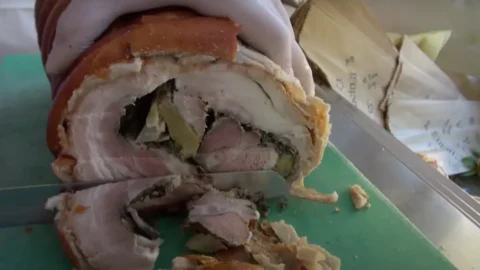It is a festival that is lost in time, the one celebrated by the peasants of Mirano, a stone's throw from Venice to celebrate the closing of the agricultural year. These days the goose is at its maximum development, full of its precious fat which gives flavor to the meat. At one time the landowners of Mirano were mostly Jews and could not eat pork, so the goose became the queen, not only of the courtyard, but also of the table.
That tradition has been taken up by the Pro Loco which has transformed it into a celebration for which people come from all over the Veneto to taste the famous goose-based preparations. But the Pro Loco has also done something more. It has also recovered the ancient "Zogo" of the goose that was played in the square.
And so on Saturday and Sunday whoever wants to go to Mirano will be able to taste all the specialties of the local goose-based cuisine such as risotto, ravioli or goose sausage, because according to a Miranese saying “Whoever does not eat the goose in San Martin does not beco de un quatrin”! but he will also be able to watch the gigantic game in the square where 63 large boxes of two meters by two have been created, for which the teams of all the Mirano factions will compete with dice and giant pawns.
′′ We couldn't wait to get back to animating our square - said Mayor Maria Rosa Pavanello - and to give continuity to this tradition, to go back to what we would always like to be normality. In these years of closure, however, the organization and the volunteers have never stopped and have worked to add new features. I want to thank them because they have never lost this desire and their team spirit».
The President of the Pro Loco Roberto Gallorini talked about the surprises planned: on Sunday for lunch it will be chef Germano Pontoni who will cook the goose risotto in Piazzetta Errera. In Villa Giustinian Morosini “XXV Aprile” the exhibition “An image for the golden goose” will be open until 14 November, with the works of 15 artists of the ARTEPIU' association who took part in the competition. The winning work, created by Annamaria Salvadori, was imprinted on the plate of the Golden Goose, an award that will be given to the winning team of the Zogo.
The game, the historical reconstruction, the typical food and wine are rooted in tradition, which saw the bird's meat become so fat and tender at that time of the year that it melted in the mouth.
All information on the Pro Loco of Mirano website: http://www.prolocomirano.it/gioco_oca_mirano.asp
Again to stay on the subject with a more historiographical approach, there is an ebook entitled “Why have Bordeaux-style red wines been produced on Montello for a century and a half? And why is it traditional here to eat goose on 11 November, the day dedicated to the cult of San Martino?” The ebook written by the food and wine journalist Angelo Peretti and available free of charge on the vinimontello.it website answers these and other questions. Veneto, can in fact be fully defined as a Bordeaux enclave in the province of Treviso derives from Celtic customs that unite these areas of the Veneto to France. In ancient times in Veneto the goose was raised as a courtyard animal and consumed between 11 and 25 November (Santa Caterina), a period dedicated to the cult of the dead.
The days between these two dates coincide with the Samuin, a Celtic celebration in which the messenger of the other world was venerated, a knight extraordinarily similar to the Christian Saint Martin, who had the goose as his symbol animal. The handed down image of the bishop of Tours, also with a goose always next to him and to whom numerous churches and oratories in the Montello area are dedicated, would therefore be none other than the transposition of the pagan god of death.
In the production area of Montello docg and Montello Asolo doc, a place that has extraordinary evidence of remote Celtic cults, red wines are made with French grapes from another area, Bordeaux, with a deep-rooted Celtic tradition. Here the Bordeaux vines (Cabernet Franc, Cabernet Sauvignon, Merlot and Carmenère), which arrived in the Veneto region in the mid-XNUMXth century, have found particularly fertile ground, also culturally. The hills made up of rocks conglomerated together and covered by marl-clayey or marl-sandy soil with a typical red colour, together with a temperate climate and underground water circulation, have allowed the Bordeaux vines to acclimate in these lands.
Thanks also to the ferrous components of the soil which give it structure and the sandstone rock which gives it minerality, the Montello wines take on their very precise identity, made up of territoriality and power.
The publication recounts the development of this local food and wine reality, illustrating it through numerous anecdotes from popular tradition and curious literary quotations, thus demonstrating how the territory of Vini del Montello bears witness to the relationship between wine, food and sacredness present in all cultures.





